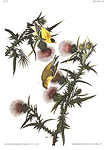| |
|
| |
American Goldfinch (Spinus tristis) |
| |
|
| |
Narrative and Science Lens 
|
| |
|
Audubon shows these birds foraging upside-down on Bull Thistle (Cirsium vulgare) an invasive here that provides food as well as down used to line its nest (which is so water-tight nestlings can drown during storms). Goldfinches breed late in the season, timed to the availability of thistle seeds.
Bull Thistle was first reported in the Bay Area in 1925 as "rather infrequent”, but is now common. Flowerheads produce about 100 to 300 or more seeds, and plants produce from 1 to over 400 flowerheads. Does foraging on the seeds of this thistle reduce, enhance, or play an insignificant role in its spread? The down readily detaches from the seed at maturity, so more than 90 percent of seeds fall close to the parent plant, but some seeds are carried by water, vehicles, farm machinery, and animals--including birds, but mostly they are carried in baled or loose hay.
Prior to the thistle invasion, American Goldfinches breeding in California used plant material from a wider variety of flowering species. During the non-breeding season, flocks often forage not only on the seeds of flowers and forbs, but also on tree seeds. They may be seen, for example, in ornamental sweet-gum trees, carefully picking seeds from the spiny fruiting structures. |
| |
|
| |
 Campus Locations Campus Locations
Fairly common migrant and winter resident in various habitats virtually throughout campus. Often forages in flocks (occasionally at feeders) during the nonbreeding season.
|
| |
|
| |
Campus sustainability |
| |
Yellow Starthistle (Centaurea solstitalis) apparently arrived in California much earlier than Bull Thistle, about the mid-1800s, and is one of California's most noxious pests. Each plant produces 700 to 10,000 seeds, which can remain dormant for a decade, and have enabled the plant to spread across roughly 8 million acres.
. What you can do |
| |
1. Look for Bull Thistle or Yellow Starthistle on campus. Their spread can be controlled by cutting them shortly before plants flower; this may need to be done repeatedly until the first frost. Cut stems may still contain viable seeds, and should be removed. |
| |
2. If these thistles are on campus and in flower, share sightings of goldfinches using them. |
| |
3. See if other goldfinch-loving native plants can be added to the Native Species garden adjacent to the Keck building.
|
| |
Science |
| |
Essays from The Birder’s Handbook: |
| |
Bird Biology and the Arts; Site Tenacity; Mixed-Species Flocking; Incubation Time; Incubation: Heating Eggs; Brood Reduction; Cowbirds
|
| |
References:
Balph, 1979; Ketterson and Nolan, 1982; Smith and Andersen, 1982.
|
| |
Videos:
|
| |
Art |
| |
Photos: |
| |
Johanna van de Woestijne's photo of an American Goldfinch from Shoreline Mountain View, CA, at some distance, shows the “weedy” mustard habitat
these birds sometimes favour. On campus Lesser Goldfinch are more often seen, in this case in the "ears" (edges) of the Oval, on the wildflowers and
weeds near the oaks. See more of Johanna's photographs.
|
| |
Drawings and Paintings: |
| |
Darryl Wheye: American Goldfinch, after Audubon--with Parental Feeding
|
| |
|
| |
To add to the Science or Art links, submit bird sightings, comment on the exhibit or the web presentation, or ask questions, please use the web forms on the Art at Exits home page. |

